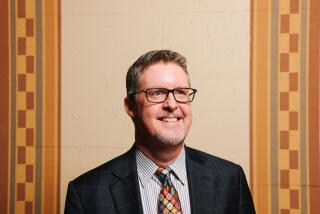Some very special collections
The first order of business at colleges and universities is to dispense knowledge. Second may be collecting stuff. And institutions of higher education in California know how to bring in the goods.
As the region’s schools have proliferated, collections of books, manuscripts, photographs, maps, artworks, costumes, scientific instruments and specimens of animals, vegetables and minerals have piled up faster than dossiers of professors, students and alumni -- thanks to gifts, purchases and research expeditions.
Every college and university has at least one library that has amassed much more than predictable texts and reference materials.
The Department of Special Collections at UCLA’s Charles E. Young Research Library -- a standard-bearer among discriminating packrats -- has acquired carpets, furniture, passports, board games and stuffed penguins, along with 330,000 rare books and 30 million manuscripts.
Meanwhile, the university’s Louise M. Darling Biomedical Library History and Special Collections has amassed an astonishingly varied trove, including acupuncture charts, ads for patent medicines, Japanese medical prints used to educate shy patients, and AIDS posters made for public health campaigns worldwide.
UC Berkeley’s vast library system harbors 400 special collections, including Mark Twain’s papers, monumental Chinese rubbings and the nation’s largest trove of Egyptian papyri.
Cal State Fresno’s library has amassed information about grape-growing, winemaking and the politics of agriculture, as might be expected, but it also has an extensive holding of material about world’s fairs from 1851 to 1940. UC Riverside’s California Museum of Photography, billed as “the largest and most comprehensive photographic center in the West,” maintains five collections, including camera equipment and the world’s largest cache of original stereoscopic prints and negatives.
Curiosities abound, but so do first-rate resources on relatively conventional topics.
The William Andrews Clark Memorial Library, under UCLA’s umbrella but located in the West Adams district, is known for its collection of English literature. It has what is said to be the world’s biggest collection of material by and about Oscar Wilde, containing 90,000 books and 21,000 letters and other manuscripts. Its John Dryden holdings are second only to that of the British Library in London. But the Clark also has a surprising stash of information about the exploration and development of the American West, including 60 early editions of the Book of Mormon and books and ephemera about Yellowstone Park.
In USC’s constellation of repositories, the Cinema-TV Library houses the Warner Bros. Archives, the world’s largest assembly of information about a single film studio. The university’s East Asian Library has a remarkably comprehensive collection of Korean heritage materials, with notable depth in such subjects as Korean immigration, independence movements, mass media, journalism, cinema and the Korean War.
Then there’s Loyola Marymount University, where the Von der Ahe Library is home to more than 1 million postcards, mostly gathered by German American photographer Werner von Boltenstern. Yet another university library, the one at Cal State L.A., has pockets of strength in printing and graphic design, bookplates and World War II posters.
Not to be outdone by the libraries, many academic departments have also built major research collections.
One of the most spectacular is at Occidental College, where the Moore Laboratory of Zoology has assembled 50,000 specimens of Mexican birds.
Said to be the most significant collection of its kind, it’s part of the legacy of Robert T. Moore, an amateur ornithologist who founded the laboratory.
“Universities are repositories of vast numbers of material things,” said Marla C. Berns, who directs the Fowler Museum at UCLA and participates in Microcosms, an effort to study UC’s “material economy of knowledge,” as it’s called in university parlance. Microcosms’ informal, statewide count of UC collections, excluding libraries, came to 150 million things, Berns said. “That includes art collections, anthropology collections, plankton collections, insect collections, botanical collections, you-name-it collections.”
College and university libraries are expected to amass huge numbers of books. Specialized research collections are also easy to understand. But what’s the point of all that other stuff?
“Material things generate knowledge,” Berns said. They also store information and embody learning. “What we know best are books that document the result of research, but collections of things themselves are knowledge,” she said. “They become the trace of what we have learned.”
*
suzanne.muchnic@latimes.com
More to Read
Start your day right
Sign up for Essential California for news, features and recommendations from the L.A. Times and beyond in your inbox six days a week.
You may occasionally receive promotional content from the Los Angeles Times.






